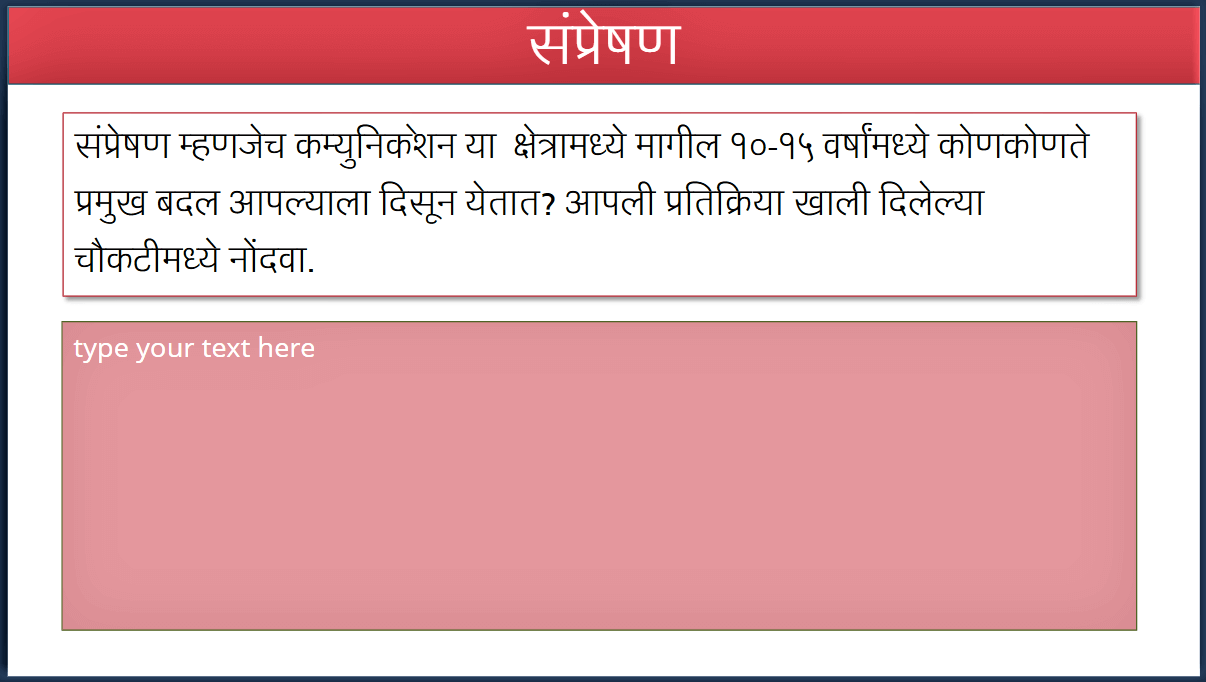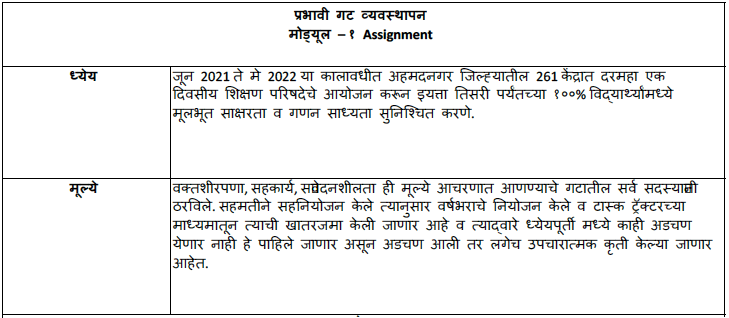This is the final article in the three-part series in collaboration with Leadership For Equity (LFE) highlighting the challenges and needs, administrative and technological, of the officers in Maharashtra’s Education Department, who play a crucial role in building the education system of the state. Read Part One and Part Two here.
In any field of work, creating digital content has two major aspects to it; one that focuses on creating digital content using softwares and the other is finding a way to make the content engaging and interactive for users. In the absence of either of these aspects, digital content could be deemed unfit to its prospective users. Similarly, online courses aimed at building professional and personal capacity in administrative officers also need to ensure that the digital content meets specified criteria and goals so that the courses are effective and enriching.
As discussed in Part Two of this series, the content created for officers in Maharashtra’s education system is different from most leadership programs offered. Launched in 2020, Leadership Enhancement and Academic Development (LEAD) is a dedicated blended learning program for the professional development of officers in the middle management of the education system. The leadership program is offered by the Maharashtra Institute Of Educational Planning and Administration (MIEPA) in collaboration with Leadership For Equity and CISCO India Cash Grant Program. The LEAD program places great emphasis on continuous improvement and continual evolution. During the implementation, course after course, various stages such as course content creation, Peer Learning Communities (PLCs), assessments, and certification, are being improved gradually to accommodate new learnings and needs.
Creating Content That Connects Theory to Practice
The content for the LEAD program has been created using the Articulate Software and contextual case studies, which help connect theoretical concepts to the real-life situations that officers might come across while at work. The content includes animated characters to bring these case studies to life, which make the characters and examples relatable to the officers. Harish Krishnan, Managing Director and Chief Policy Officer at CISCO Systems – India and SAARC, says, “The LEAD Program innovatively approaches the design and implementation of professional development courses for officers. An immersive learning experience made possible by technological tools provides an opportunity for officers to be active members in their learning journey.”
Another aspect of the content creation process is making the content interactive and actionable for the officers. While designing the course, the team ensures that a ‘Check for Understanding’ is included at every stage that gives opportunities to officers to express their opinions, feelings, ideas, and thoughts. This critical aspect offers the participants a space to actively participate in the course as opposed to passively receiving information. Additionally, the blended format, Peer Learning Communities (PLCs), and assignments provide hands-on practice and spaces for the officers to collaborate with their peers.

Learnings from the LEAD Courses
When it comes to implementing programs such as LEAD, making decisions backed by data and feedback from participants plays an important role. Since courses under the LEAD program are credit-based, various types of data are collated by using a Data Management Sheet (DMS) Tracker to assess and provide final certification. Typically, data is collected on course consumption, responses to interactive questions asked during the course, PLC participation, and assignment grades. These data pointers give insights into participation patterns and inform decisions during the implementation of the course. For example, the participants’ responses in the online module, help in understanding the gaps in learning and common misconceptions among the officers. This data helps design PLCs in a way that addresses the learning gaps and ensures that officers have thorough and adequate understanding of every aspect of the course.
The LEAD courses provide subjective assignments assigned to each module in the course. The assignments provide a platform for officers to apply concepts learnt in the course in their daily life and present them as their submissions. For example, in the SEL course, officers are asked to use the facilitation technique discussed in the course to facilitate a mock meeting and submit the recording of it. Since these tasks are very open-ended and flexible, detailed guidelines document, rubrics, and support is provided.

As the implementation partner, we have been able to provide this technology platform to make LFE’s LEAD program accessible to education officers across multiple states in the country. The large-scale reach of these programs that focus on capacity building on varied topics is commendable and the enthusiasm from the participants is also very evident. The success of these programs stems from LFE’s team’s ability to plan, design and support the participants throughout the implementation.
—Ashwath Bharath, Director, Firki
The LEAD program has also evolved into creation of practices that have been adopted by government partners such as the Maharashtra Institute of Education Planning and Administration (MIEPA), who along with LFE have designed and implemented the LEAD program. MIEPA has adopted the blended learning model for its STARS training program in Maharashtra. Significant amount of time is allotted for PLC meetings with participants to supplement the online modules. Along with this, monitoring and evaluation structures have also been adopted for the implementation of their course. The officials from MIEPA are now tracking the course-related data from Firki, analysing it to make timely decisions.
…the LEAD program helps officers develop the skills they need to be successful through the inclusion of technology. Exposure and subsequently, knowledge gained through these courses will help individuals grow and thrive in a world powered by digital technologies.
—Harish Krishnan
Leading Self-Sustaining Professional Growth of Officers
The experience of the implementation journey so far along with the valuable feedback from the participants, have helped in identifying five key areas for further improvement. Firstly, to make content cadre-specific as they vary—from Deputy Director to Cluster Head. Since their roles and responsibilities differ vastly, a good way to proceed is personalised content for each cadre. Secondly, to make courses in multiple regional languages, so as to cater to middle-managers across various regions of the country. Thirdly, seamless integration of chatbot services for officers, which will provide efficient and real-time support to officers, and immediate response to queries. Chatbots could also be used for engaging with the officers after course completion. The fourth area identified as a viable option for expansion is to design a system to extend support to officers after course completion. This will ensure effective adoption and execution of best practices in the officers’ daily operations. Finally, to create an open digital platform for all the officers involved in the LEAD Program to connect, collaborate, and share their best practices with their peers.
The vision behind the LEAD program is to make a self-sustainable structure for officers’ professional development. To achieve this, it is vital to leverage the potential of officers. The LEAD program envisions collaborating with officers who have completed the courses so that they can mentor the upcoming batches. “We strongly believe that the LEAD program has supported officers in enhancing their skills and ensuring its easy adoption in their sphere of influence. An aspect that stands out and is unique to this intervention is that it creates capacities within the system that has a multiplier effect, since each official trained can impact and support teachers as well as students. Additionally, the cascading impact is not just for the year of intervention but also for the long term,” says Harish.

Things to Remember While Implementing Large-Scale Blended Program
For any organisation hoping to launch a large-scale blended program, there are a few takeaways from the implementation of the LEAD program. Damini Mainkar, Chief Operations Officer (COO) at Leadership For Equity, shares that the problem of capacity building of middle managers in public systems needs to be thought of differently, one that envisions effective delivery at scale.
A good starting point is to conduct a ‘Training-Need Analysis’ that includes officers from different cadres across the state. Once the training needs have been identified, the next step would be to combine research-based content and the context of the officers. For this, it is recommended to tie up with government bodies and include its officers in the brainstorming activities and decision-making processes. While developing content, care should be taken to give agency to the participants. This can be done by making the content interactive and informative, which provides the participants with a wholesome learning experience. Finally, having a strong system of monitoring and evaluation of the courses makes it possible to improve the quality of the courses.
The LEAD program started out from a training need analysis which brought out various administrative and technological needs of the middle-managers within the Education Department of Maharashtra. It has evolved into a large-scale blended learning program which delivers online modules through technology integration and a community experience which is implemented by Peer Learning Communities. Collaborations with a government body MIEPA and technology partners CISCO and Firki have been critical to ensure the contextuality and high quality of the courses. During this process a strong monitoring and evaluation process has brought key insights and an outlook to continuously evolve.
We were fortunate to have supporters that helped us experiment with technology and setting the idea of self-learning in the officers. At LFE, this was our first attempt to create content that suits the needs of our stakeholders and also open the doors to global practices to be used in our schools. Prototype with 50 officers gave us more critical feedback on the content designed but the process of blended-learning was appreciated. This builds our confidence to take the work forward and have some champions from the system that helped us co-create the content for Maharashtra.
—Damini Mainkar
Along with expanding to new landscapes, the LEAD program envisions to be more cadre specific, integrate new technologies such as Chatbot, and actively involve government officers in the design and implementation process. It is hoped that LEAD will not just create customised open-source learning resources for middle managers, but also explore the idea of continuous professional development structures leveraging technology in specific and localised contexts.
Featured image is of a team member from Leadership for Equity facilitating a training session for capacity building with officers in Tripura; image courtesy: Leadership for Equity.







Great insights on how technology is empowering education officers in Maharashtra! Just like the right tools build capacity in education, businesses thrive when they operate from the Best Office Spaces that foster growth and innovation. For expert guidance in finding premium office spaces, I highly recommend Address Advisors—helping businesses set up in the most strategic locations.